USS Pennsylvania
This is attribute to Mark R. Smith aka Gunny a resident of the great state of Pennsylvania. I can only hope it’s a fitting tribute to the fine ship the USS Pennsylvania, those that sailed in her and to Mark and all the fine residents of the state of Pennsylvania.
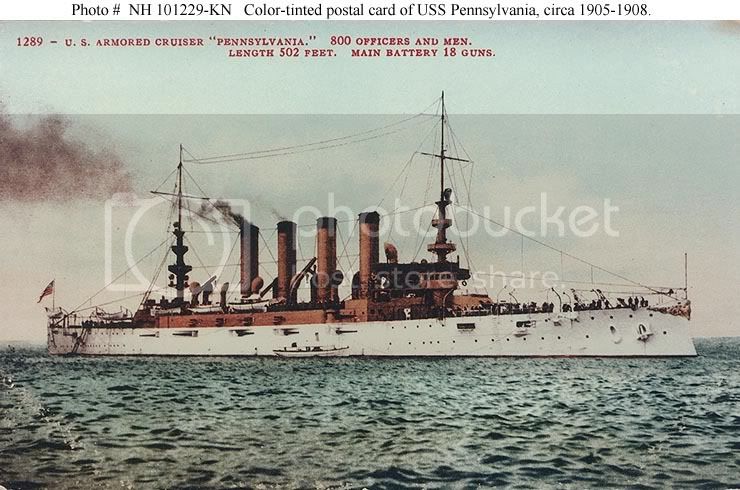
General Statistics
Displacement: 13,400 tons
Length: 504 feet
Beam: 69 5 in feet
Draft: 24 1 in feet
Speed: 22. knots
Complement: 829 officers and men
Armament: 4 x 8 inch guns
14 x 6 inch guns
18 x 3 inch guns
A picture of USS Pennsylvania anchored at Oyster Bay, New York, during the Presidential Naval Review held on 4 September 1906.

President Teddy Roosevelt reviewed the Fleet anchored there. Another of her sister ships can be seen in the background. This is the USS Colorado as only the Colorado and Pennsylvania had the large ventilator in front of the fore funnel. The other four ships in the Pennsylvania class did not have this ventilator. Some of the ships that were reviewed by President Roosevelt were the; USS Virginia BB-13, USS New Jersey B-16, USS Florida Monitor No. 9, USS Denver C-14, USS Des Moines C-15, The Auxilliary Cruiser USS Yankee, USS Hopkins.
The USS Pennsylvania (Armored Cruiser 4) was laid down the 7th of August 1901 by William Cramp and Sons, Philadelphia; launched 22 August 1903; sponsored by Miss Coral Quay, daughter of Senator Matthew S. Quay; and commissioned 9 March 1905, with Capt. Thomas C. McLean in command
A souvenir button from the 22 August 1903 launching ceremony
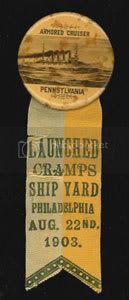
USS Pennsylvania operated on the East Coast of the United States and in the Caribbean until 8 September 1906 when she cleared Newport News, Virginia for duty with the Asiatic Fleet.
During 1907 Pennsylvania along with the cruisers USS Colorado, USS West Virginia and USS Maryland formed the First Division of the First Squadron, Asiatic Fleet, Commanded by Rear Admiral Willard H. Brownson. On 2 September 1907 all 4 cruisers were at anchor in Honolulu, Hawaii. Pennsylvania returned to San Francisco, California on 27 September 1907 for West Coast duty. A year later she was again cruising the waters of the Pacific and on the 16th of September 1908 she crossed the equator. In the autumn of 1909, she deployed westward with the Armored Cruiser Squadron and on 5 September 1909 the West Virginia, California, South Dakota, Pennsylvania, Colorado and possibly the Maryland departed San Francisco, California and arrived on 11 September in Honolulu, Hawaii steaming 2,100 miles. The force called on ports in the Admiralty Islands, Pago Pago on Tutuila Island on American Samoa, the Philippines, Japan, and China, before returning to Honolulu on 31 January 1910.
The USS Pennslvania in the Dewey Drydock at Olongapo, Philipines
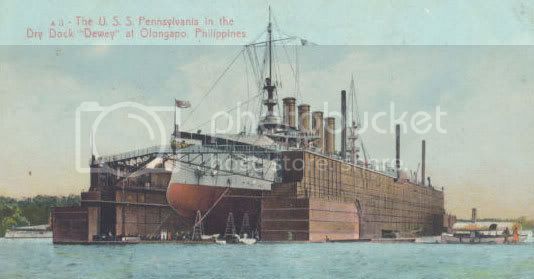
Pennsylvania spent Christmas of 1909 anchored at Hong Kong, China. After return from Far Eastern waters Pennsylvania saw South American duties and she cruised off Chile and Peru.
In February of 1910 the Pennsylvania was under the command of Lt. Cdr. W. Evans. It is known from letters written to loved ones by members of the crew that Pennsylvania was on 2 May 1910 anchored at the Navy Yard in Bremerton, Washington. During the later half of 1910 she underwent a refit and her original foremast was replaced with the new cage style mast as did the other six ships in her class. In the December 4th, 1910 edition of the Washington Post, under the Movements of Naval Vessels section the USS West Virginia, Maryland, South Dakota, California, Colorado and the Pennsylvania all arrived in port at San Diego, California.
During the winter of 1910-1911, a plane landed on and took off from a platform constructed on her afterdeck, opening the era of naval aviation. At the Mare Island Navy Yard, California in January 1911 she was fitted with a temporary wooden deck in preparation for Eugene Ely's airplane landing attempt.
A picture of the USS Pennsylvania at the Mare Island Navy Yard, California, being fitted with the temporary wooden deck.
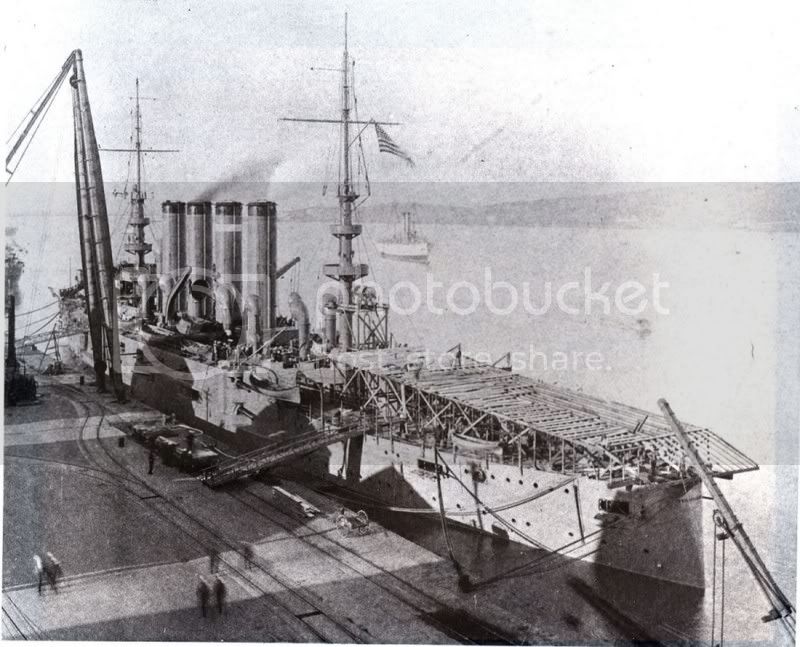
Upon completion of her flight deck Pennsylvania cruised to San Francisco Bay, California, where she anchored for the Eugene Ely's historic flight.
Aviator Eugene B. Ely stands by his Curtiss pusher biplane, just before taking off from the USS Pennsylvania to return to land, 18 January 1911. Note the light emergency floats under the plane’s lower wings and Ely’s flying attire, including rubber inner tubes worn under his shoulders as a life preserver.
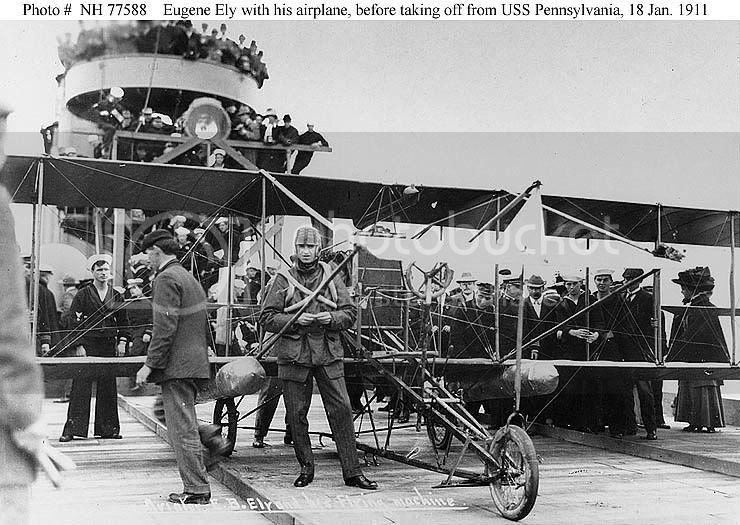
Ely landed his Curtiss pusher biplane on board the ship on the morning of 18 January 1911, the first airplane landing on a warship.
Picture of the first airplane landing on a warship 18 January 1911. Eugene B. Ely lands his Curtiss pusher biplane on the USS
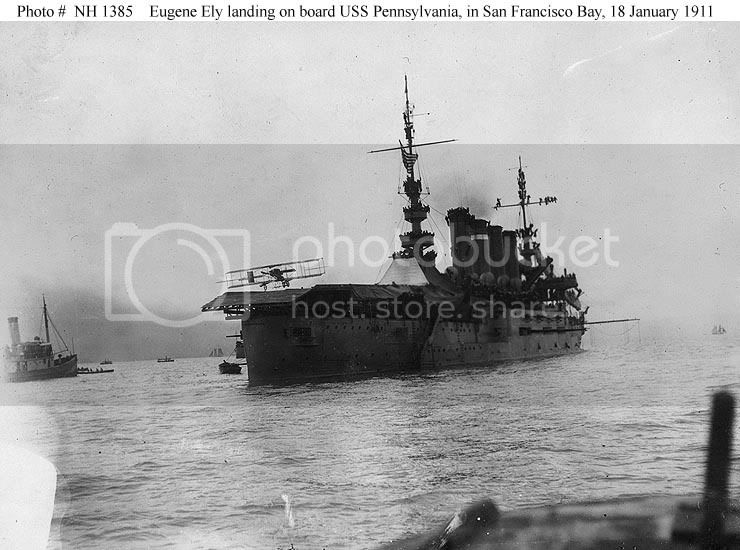
The landing deck, 120 feet long and 30 feet wide, was inclined slightly to help slow the plane as it landed, and had a thirty-degree ramp at its after end.
Eugene B. Ely’s Curtiss pusher biplane flying off the aircraft platform on the US P 18 January 1911. P was anchored in San Francisco Bay, California.

Another picture of Eugene B. Ely’s Curtiss pusher biplane flying off the aircraft platform on the US Pennsylvania 18 January 1911
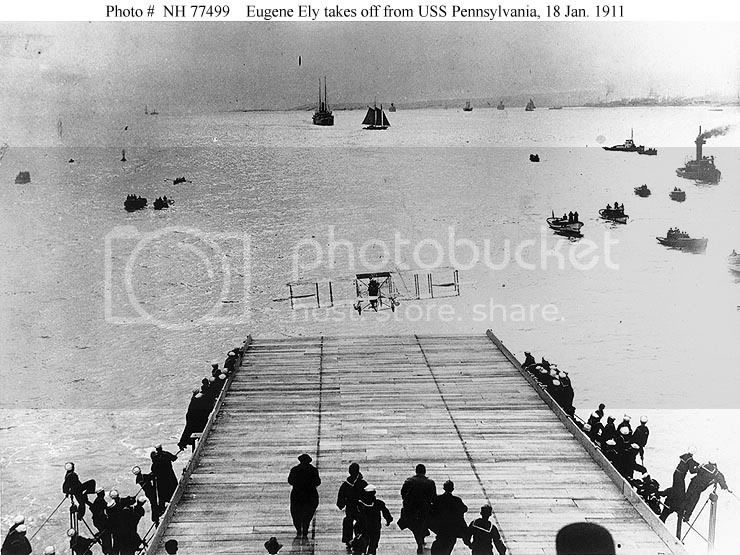
She then sailed to San Diego Bay, California, and on 17 February 1911 additional test flights were conducted. Glenn Curtiss the designer of the Curtiss Hydroaeroplane was on board for these tests.
From 1 July 1911 to 30 May 1913, while in reserve at Puget Sound, Washington her duties were training of naval militia. She was renamed Pittsburgh on 27 August 1912 to free the name Pennsylvania for a new battleship. Re-commissioned, Pittsburgh patrolled the west coast of Mexico during the troubled times of insurrection which led to American involvement with the Vera Cruz landing in April of 1914. Later, as an impressive symbol of American might and concern, she served as flagship for Admiral William B. Caperton, Commander in Chief, U.S. Pacific Fleet.
In the days before America entered WWI, Pittsburgh took part in South American patrols in cooperation with the British, scouting for German and Austrian raiders and acted as a powerful deterrent against their penetration of the eastern Pacific. On 20 May 1917 the Pittsburg along with the USS Frederick and USS South Dakota entered the Canal at Balboa transiting to join the Atlantic Fleet. From a report from the USS Stewart the USS Pueblo on 16 May, was moored to the dock in Balboa along with the USS St. Louis, USS Whipple and the USS Truxtun was in the dry dock. The next day the Pueblo went into the dry dock at Balboa for repairs from her fight with the German Raider. Finished with repairs on 21 May, Pueblo comes out of the dry dock and the USS Pittsburg entered the dry-dock. She joined Pueblo (ACR-7), and Frederick at Colon, Panama, on 29 May 1917 then proceeded to the South Atlantic for patrol duty operating from Brazilian ports protecting shipping, paying diplomatic calls to South American ports, and preventing the sailing of German and Austrian ships interned at Bahia, Brazil.
At Hampton Roads 16 May 1917, Pittsburg in company with the USS Nebraska departed for Montevideo, Uruguay with the body of the late Carlos M. DePena, Envoy Extraordinary and Minister Plenipotentiary from Uruguay, with full honors. The Nebraska and Pittsburgh arrived in Montevideo on 10 June 1917. The Commander in Chief, U.S. Pacific Fleet, came on board for the ceremonies and the body of the late Uruguyan Minister to the United States was transferred with full honors. Nebraska and Pittsburgh departed Montevideo on 15 June for home.
After returning from Montevideo the USS Pittsburgh along with the USS Frederick, USS Pueblo and USS South Dakota proceeded to the South Atlantic for patrol duty operating from Brazilian ports. On 23 July 1917 while steaming toward Buenos Aires, Argentina an accident occurred when a saluting charge exploded and injured several men, one of which died as a result of the explosion. Gunners Mate Clay Tenny Lyles died on the 23rd from injuries from the explosion. Gunner’s Mate Lyles was born on 17 October 1896 in Texas and was 20 years old when he died. According to an article in the 26 July edition of the Washington Post, Gunner’s Mate Lyles body was buried at sea on the 25th of July, but other sources indicate that he is buried in the Lyles Family plot in Garland Memorial Cemetery in Garland Texas. The incident happened when a 3-inch saluting charge exploded and caught fire of some material on the deck. The fire now threatened to ignite the powder supply and that could have caused a devastating and possibly fatal explosion to the men as well as to the ship. As a result of the cool and heroic action of Commander Willis Winter Bradley, Jr. and Seaman Ora "Pappy" Graves who put out the fire, both men were awarded the Medal of Honor for their actions that day.
At Rio de Janeiro, Brazil, circa 1917-1918

Pittsburgh was at anchor in the harbour in Rio de Janeiro, Brazil on 17 August 1917 along with some British ships one of which was the HMS Glasgow. During January 1918 while the Pittsburgh was in Rio de Janeiro, Brazil there was a murder on board and 5 crewmen were imprisoned. They were transferred to the Coalier USS Cyclops for trial. The Cyclops sailed for Bahia, Brazil on 21 February and then on 4 March 1918 she sails from Bahia for Baltimore, Maryland and was never heard from again, lost in the famous Bermuda Triangle disappearances.
The USS Pittsburgh as she enters the floating dock in Rio de Janeiro

In a floating dry dock at Rio de Janeiro Brazil circa 1917-1918
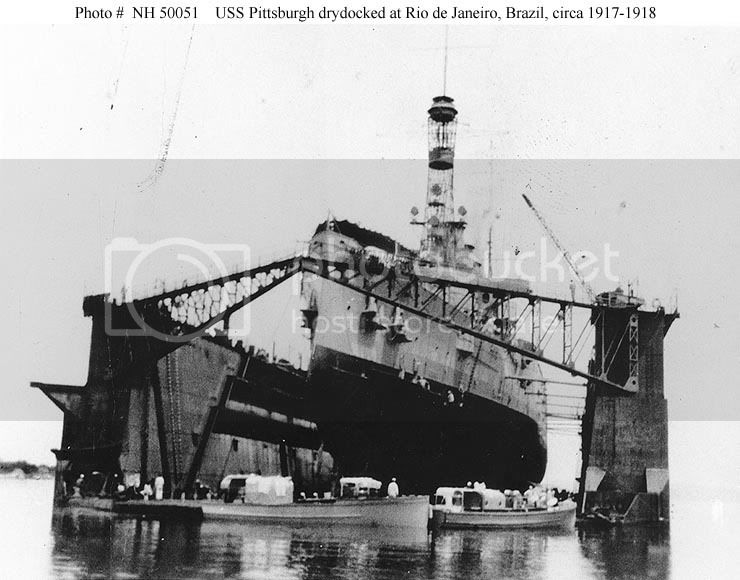
Around the end of June 1918 Pittsburgh and the USS Vermont were patrolling the waters off Antofagasta, Chile protecting American interests and preventing Austrian and German ships from sailing. It was during the last week of June that the USS Radnor a US Navy cargo ship made port in Antofagasta, Chile on the 28th of June, but due to she being a US Navy ship tensions were high in Antofagasta and the Radnor was ordered out of the harbour by the German ambassador or she would be interned in port. Lt. Comdr. Marcus S. Harloe, Captain of the Radnor radioed for help and the USS Vermont and USS Pittsburgh answered the call. Radnor readied for sea in a hurry and Vermont and Pittsburgh arrived and escorted Radnor to safety before hostilities started.
In a harbour in the Adriatic Sea area, circa 1919
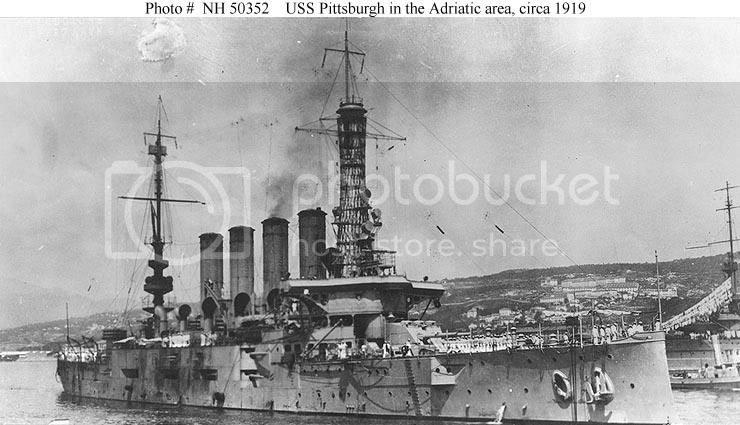
Returning to the East Coast, Pittsburgh prepared for duty as flagship for Commander, U.S. Naval Forces in the eastern Mediterranean, for which she sailed from Portsmouth, N.H., on 19 June 1919. Cruising the Adriatic, Aegean, and Black Seas, she joined in the massive relief operations and other humanitarian concerns with which the Navy carried out its quasi-diplomatic functions in this troubled area. Pittsburgh was at anchor in San Marco Bay in Venice, Italy on March 14, 1920.
Moored in San Marco Basin, Venice, Italy in 1919
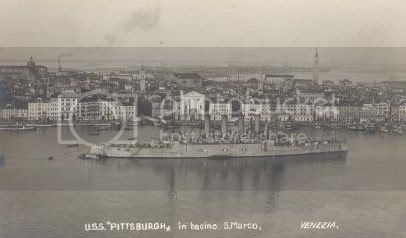
Another shot of the USS Pittsburgh in Venice.
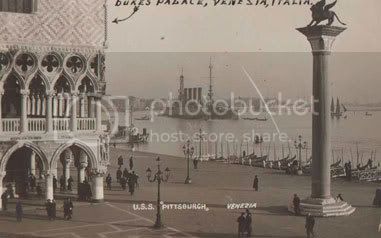
On 26 April 1920 she left Broussa, Turkey for the Black Sea. In June of 1920, she sailed north to visit French and British ports and cruise the Baltic on further relief assignments before returning to decommission at Philadelphia on 15 October 1921.
The USS Pittsburgh at Villefranche, France on Christmas Day, 1920. The officers and men entertained about 200 French children to a Christmas dinner on board, afterwards presenting them with presents. You can see the excited poor French children waving American flags and admiring their presents on board.
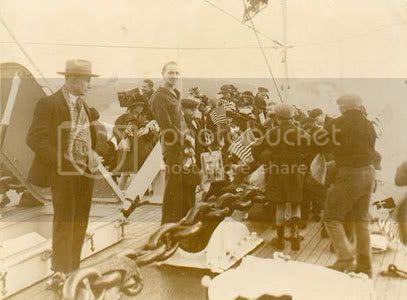
The Pittsburgh was made flagship of Vice Admiral Henry McLaren Pinckney Huse on 24 June 1920 who was Commander, U.S. Naval Forces in European Waters. On the 28th of August 1920, at the request of the United States State Department, Navy Secretary Daniels send orders to Admiral Huse who was in command of the US warships then in the Baltic area to take his flagship the USS Pittsburgh then at Reval, Estonia to Danzig, Poland in order to protect the considerable number of Americans there in that port. Reval is the present day capitol city of Tallinn, Estonia located on the Baltic coast between the Paaskula and Pirita Rivers. There was some concern that tensions in the area were growing and the State department thought is a wise move to have the presence of a US warship in the area.
At 10:20 on the evening of September 9, 1920 the Pittsburgh ran aground on some rocks 3 miles off the port of Libau near the breakwater. This is the present day city of Liepaja, Latvia and Libau was the name used during the German occupations of WWI. In a dispatch from Admiral Huse the Pittsburgh was in “no immediate danger” but several sections of her double bottom were flooded. As soon as the Navy Department was advised they sent a dispatch to the USS Frederick, which was then stationed in Antwerp, Belgium. She was carrying the United States Olympic rowing, swimming and running teams to the Olympic games being held in Antwerp. The Frederick was to disembark her passengers and precede at best possible speed to render assistance to the Pittsburgh. Frederick got underway at noon on the 10th of September heading down the Scheldt River. At 7:30 on the 14th of September the Frederick was just outside the breakwater off Libau where she found the Pittsburgh afloat with the HMS Dauntless standing by her. On the 18th the Pittsburgh off loaded her ammunition to the Frederick. That evening at 8:00 PM a smoker was held on the deck of the Frederick in which Vice Admiral Huse and his staff were the guests. Two three-round boxing bouts were held and the final bout was a six-round bout of Browne vs. Crosby, both of the Fredericks engineer force. Crosby was the winner. Movies were then shown on the quarterdeck.
In a Mediterranean port, circa 1923-1926
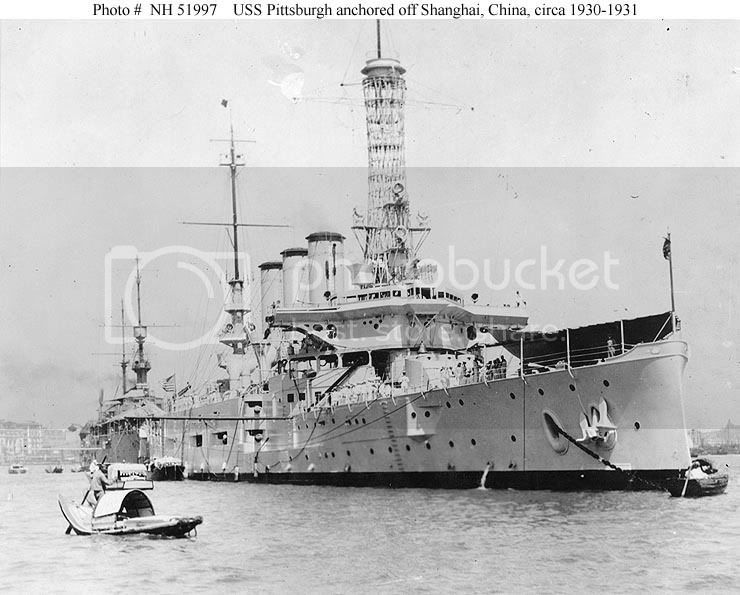
On the morning of the 19th of September at 7:30 the Pittsburgh got underway steaming at 8 knots with the Frederick following astern acting as her escort. Both ships steamed to Sheerness, England where the Pittsburgh went into dry-dock for repairs. She reached Sheerness at 10 in the morning on the 23 of September 1920.
Alongside a wharf, possibly in a European port, circa 1920
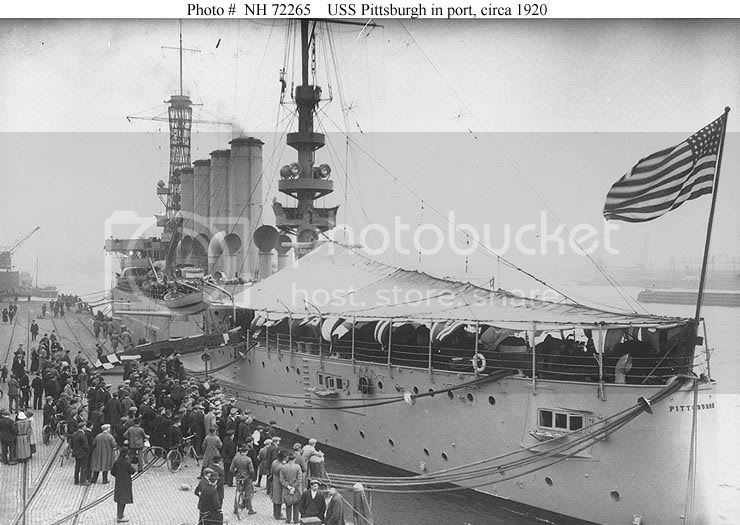
In April of 1921 Pittsburgh still serving in European waters, was under the command of Captain Joseph Mason “Bull” Reeves. His command of the Pittsburgh only lasted until October 1921 when he was re-assigned as Commander, Navy yard, Mare Island, California. Reeves later would retire from the Navy at the rank of Admiral and distinguished himself by served in the Spanish-American War, WWI and WWII and it was largely through Admiral Reeves foresight that the foundation of modern carrier striking forces are based on today.
Re-commissioned again on 2 October 1922, Pittsburgh returned to European and Mediterranean waters as flagship of Naval Forces in Europe.
In a Mediterranean Port circa 1923-1927
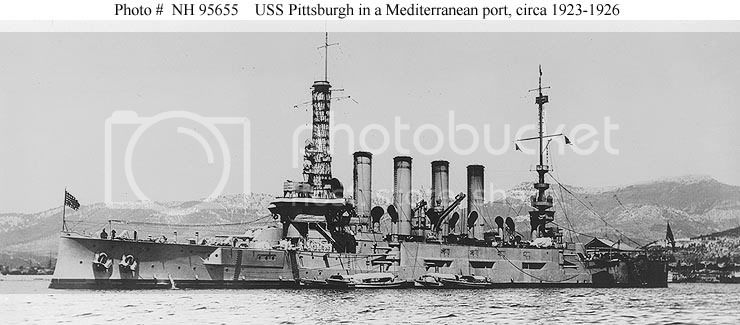
She then arrived in New York on 17 July 1926 to prepare for flagship duty with the Asiatic Fleet. She under went a refit for her Asiatic duties and her fore stack is removed changing her to a 3-stack design. She was the only ship of her class to be so modified. Gun directors were placed on the bridge just abaft of the mainmast and one large ventilator installed just aft of the bridge area.
Underway at sea, circa 1926-1931, as refitted for service as Asiatic Fleet Flagship. Note the dense smoke from her boiler fires.
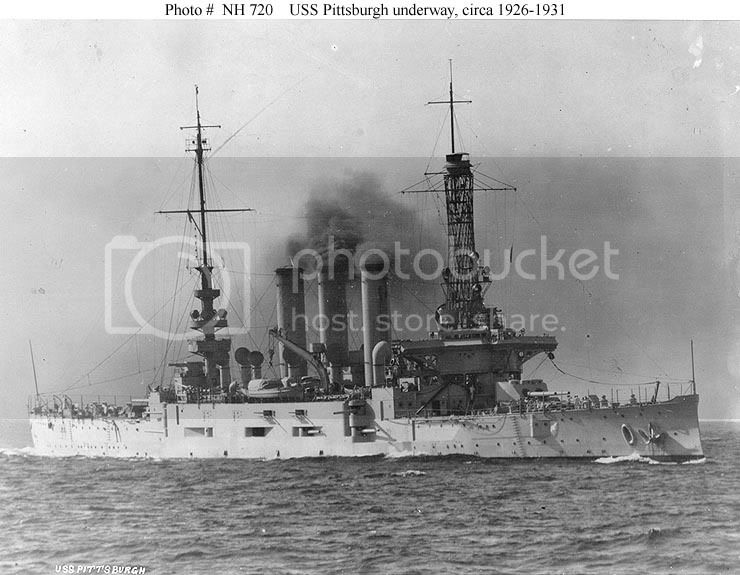
She sailed on 16 October for Chefoo, China arriving there on 23 December 1926. Early in January of 1927, she landed sailors and Marines to protect Americans and other foreigners in Shanghai from the turmoil and fighting of the Chinese power struggle.
Members of the USS Pittsburgh’s landing force in a boat of Shanghai, China in 1927
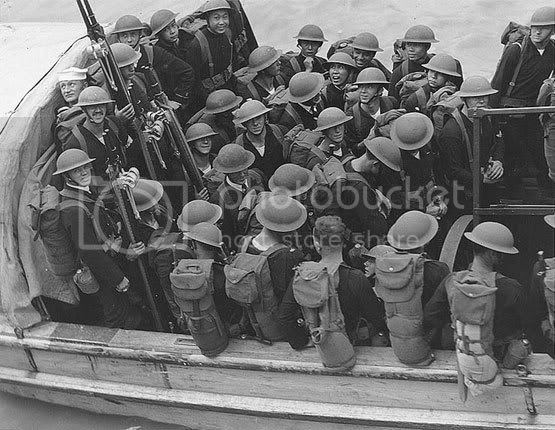
When Chiang Kai-shek's Cantonese Army won control of Shanghai in March 1927, Pittsburgh resumed operations on patrol and exercises with the Asiatic Fleet. On 28 March 1928 Pittsburgh was in Hong Kong, China according to post cards mailed from the ship and cancelled with Hong Kong postmarks.
In the book “The Sand Pebbles” by Richard McKenna, which was also made into the famous movie by the same name starring Steve McQueen there is a passage that refers to the USS Pittsburgh. McKenna wrote this book, which tells the story of the men in the US Navy known as “China Sailors” of 1926. This was also the beginning of the start of the Pittsburgh’s tour as Flagship of the Asiatic Fleet from 1926-1931. It refers to something that happened while in South America several years previous, which is likely to be the murder that took place on the Pittsburgh during January of 1918 while the Pittsburgh was in Rio de Janeiro, Brazil. In those days “China Sailors” were clearly regarded in a poor light. In the movie “The Sand Pebbles” Jake Holman played by Steve McQueen tells Shirley Eckert (Candice Bergen) “…nice American girls don’t talk to China Sailors.” Even the local Chinese mock them and their superior officers treat them badly and the people whom they protect regard them as an embarrassment. McKenna reminds us in his book that the US Navy of the 1920’s was not necessarily seen as a career (except by the officers), but often as a means of escape or even punishment for the lowly China Sailor.
This may help explain the following reference form McKenna’s book, in which the implication was that the Pittsburgh had a bad reputation, with one character saying “I would rather have my sister in a whorehouse then have my brother serve on the USS Pittsburgh.” A second sailor replied, “I would rather have your brother.” In the book, the next day the second sailor received a warning in the form of a scrap of canvas with a pile of wet sand on it. This canvas warning likely refers to the old tradition in the navy known as “cobbing” or being beaten with a stocking filled with wet sand. There was no doubt that to the sailor who received the sand on his bunk that this was an old seagoing warning and that the message was very clear.
Murder on navy ships of the line is not a new thing as life within the hulls of any ship is a small sampling of the larger population and so we should expect that this would happen from time to time. An example of this would be the murder that happened onboard the USS Columbia in 1921 in which two crewmen did not get along and one man killed the other in a fit of rage.
USS Pittsburgh underway, circa 1929

Closing her long career of service, she carried the Governor General of the Philippines, Dwight F. Davis on a courtesy cruise to such ports as Saigon, Bangkok, Singapore, Belawan Deli, Batavia, Surabaya, Bali, Macassar, and Sandakan, returning to Manila on 15 April 1931. Six days later, she steamed for Suez enroute to Hampton Roads, Virginia arriving there on 26 June 1931. She was decommissioned for the last time on 10 July 1931 and on 8 October of that year was used by the navy in some bombing experiments as a target.
The decommissioned ship being used in bomb tests, 8 October 1931. This photograph shows the explosion of the first 500 pound bomb in the test series.
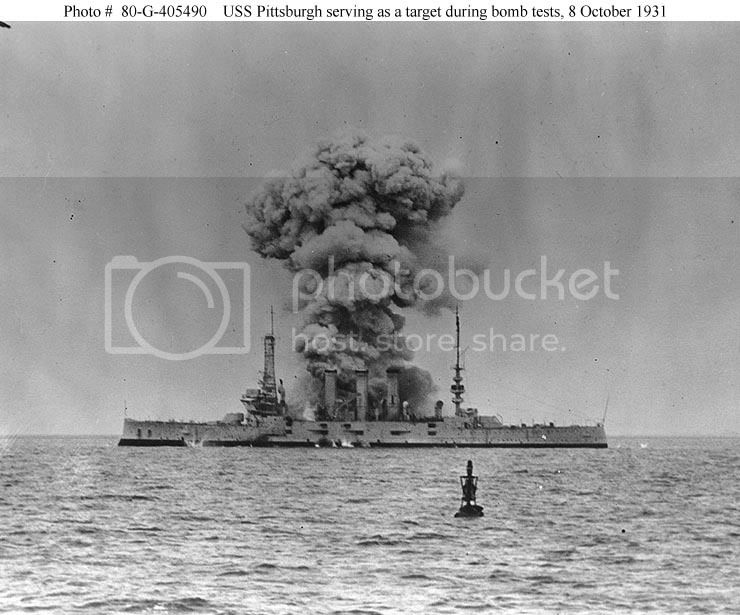
Pittsburgh was sold for scrapping under the terms of the London Treaty to the Union Shipbuilding, Baltimore, Maryland on 21 December 1931.
The bow ornament of the Pittsburgh was presented to the Carnegie Institute of Technology in Pittsburgh, Pennsylvania, where it was installed overlooking Junction Hollow at the western edge of the school's campus. Today the ornament resides in the Carnegie Institute's archives; a replica of it, however, is still in place at the modern Carnegie Mellon University
Credit to Joe Hartwell
Cheers
Sean









